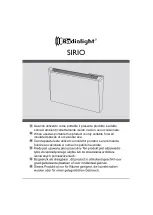
12. TECHNICAL SERVICE
In order to provide long-term and failure-free operation of the appliance and to keep its operating characteristics it is
necessary to regularly effect the examination, treatment and technical service.
In order to provide fire safety it is necessary to be on the outlook for
the burners’ cleanness, to prevent the appear-
ance of smoky flame at gas combustion, which leads to soot deposit on the heat exchanger. In this case the spacings
between the heat exchanger’s gills are covered with soot, in consequence to this the flame casts out of the combustion
chamber, what may lead to fire.
The examination and treatment are effectuated
by the appliance’s owner.
The appliance
’s technical service is effectuated by a specialized service organization, not later than 12 months after
the appliance’s installation and further not less frequently than once in 12 months.
ATTENTION! The works connected with technical service are not the manufacturer company
’s warranty
liabilities and are effectuated
at the customer’s cost.
12.1. Examination
12.1.1. Every time before putting the appliance into operation it is necessary to:
Make sure that there are no highly flammable objects next to the appliance;
Make sure that there is no smell of gas in the premise, in case of detecting the gas smell it is necessary to call
the gas facilities emergency service.
12.1.2. After igniting the main burner it is necessary to visually check its operation: the flame must be blue, straight
and have no yellow smoky edges which indicate the
burners’ sections’ inner channels dirtying.
The burner
’s sections’ inner channels dirtying causes incomplete gas combustion, what leads to the following
consequences:
Appearance of carbonic oxide (sweetdamp) in big amounts, which may lead to poisoning;
Appearance of soot in big amounts and its deposit on the heat exchanger, which worsens heat exchange and
may lead to the appliance
’s breakdown.
12.2. Treatment
12.2.1. The appliance must be kept clean, for this it is necessary to regularly remove dust from the appliance
’s upper
surface,
and also to wipe the appliance’s casing first with a moist and then with a dry wiper. In case of sustainable dirty-
ing, you should first wipe the casing with a wet wiper, moistened with a neutral detergent, and then with a dry wiper.
12.2.2. It is prohibited to use detergents of heightened effect and containing abrasive particles, gasoline and other
organic solvents for cleaning the casing
’s surface and plastic details.
ATTENTION! All appliance treatment operations must be effectuated only after it is switched off and has cooled
down.
12.3. Technical service
At technical service following works are effectuated:
Cleaning of the main and ignition burner;
Cleaning
of the heat exchanger from soot and cleaning (washing) the heat exchanger’s pipes from scale deposit
(if necessary);
Replacing the sealings in the gas and water systems;
Checking the gas and water systems of the appliance for airtightness;
Checking the thermorelay
’s (draught sensor’s) operation
Lubrication of flexible joints (if necessary);
Unscheduled cleaning of the appliance (also from dust in the inner blocks and details).
ATTENTION!
It is necessary to effect the technical service operations connected with disassembling of its water or
gas pipelines only after the appliance is completely switched off
(the taps on the water and gas pipelines by the inlet
into the appliance must be closed).
12.3.1.
Cleaning the burners
For cleaning the main burner it is necessary to effect the following operations:
a) Switch the appliance off and close the gas stop valve;
b) Remove the casing (see p. 7.2.1), remove the burner and disconnect the collector from it;
c) Remove dust with a brush from the external surfaces of the burner and from the collector;
d) Wipe the collector and nozzles with a moist wiper;
e) Remove dust with a bottle brush
from the burner’s section’s inner channels;
f)
Clean the electrodes of the ignition plug and flame sensor from soot deposit and clean up their contacts;
g) To wash the burner with a soap solution, especially the internal cavities of its sections with the help of a bottle
brush, wash it thoroughly with flowing water, dry and put it back.
Keeping the burners clean will prevent the heat exchanger from soot dirtying and will prolong its working
lifespan.
12.3.2.
Cleaning the heat exchanger
In case of the heat exchanger
’s dirtying it is necessary to effect cleaning of its surfaces, on which soor deposit
appeared,
and of the heat exchanger’s pipes when scale deposit appears in them.
In order to remove soot it is necessary to:
a) Remove the heat exchanger and put into hot soap solution or a solution of another synthetic detergent;






































